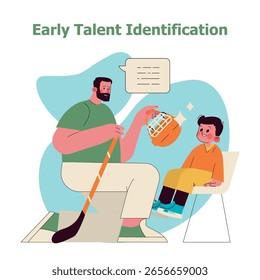Early talent identification in sport has become a focal point for coaches, organizations, and policymakers aiming to nurture the next generation of elite athletes. As programs worldwide invest significant resources into spotting prodigious abilities at increasingly younger ages, a heated debate has emerged over the benefits and drawbacks of this approach. While early identification can accelerate development and allocate support more effectively, critics warn of potential pitfalls including burnout, inequality, and undue pressure on young athletes. In this article, we examine both sides of the argument to provide a balanced perspective on whether early talent identification truly serves the future of sport.
The Benefits of Early Talent Identification for Athlete Development
Early identification of athletic talent can significantly enhance the developmental process by allowing access to tailored training programs and resources at a crucial stage. Athletes recognized early often benefit from specialized coaching, nutritional guidance, and psychological support, optimizing their physical and mental growth. This proactive approach also gives sports organizations the opportunity to nurture potential stars within structured environments, minimizing the risks of burnout and injury through monitored progression.
Moreover, early talent detection can foster a competitive edge by promoting goal-oriented mindsets and resilience from a young age. Young athletes gain exposure to high-level competition, building confidence and refining skills that set them apart on the path to elite performance. Key advantages include:
- Access to expert development resources tailored to individual needs
- Increased motivation and focus sparked by early recognition
- Opportunity for strategic long-term planning in athletes’ careers
- Enhanced injury prevention through informed training loads
| Age Group | Focus Area | Potential Outcome |
|---|---|---|
| 6-10 years | Fundamental movement skills | Strong athletic base |
| 11-14 years | Sport-specific skills | Technical refinement |
| 15-18 years | Competitive preparedness | Elite performance readiness |
Challenges and Risks Associated with Early Specialization in Sport
Early specialization in sport often comes with a complex web of challenges that can impact young athletes both physically and psychologically. The intense focus on a single discipline during formative years increases the risk of overuse injuries, as repetitive motions place undue stress on developing bodies. Moreover, such narrow focus may contribute to burnout, leaving young talents emotionally drained and disengaged. Studies have shown that athletes who specialize too soon may experience a decline in motivation and enjoyment, factors critical to long-term success and well-being.
Beyond the immediate physical consequences, there are broader risks associated with limiting athletic experiences too early. Early specialization can hinder the development of a wide range of motor skills and reduce opportunities for social interaction within diverse team environments. This lack of varied engagement may also result in missed chances to explore other sports or interests, potentially stifling overall personal growth. Below is a summary table highlighting key risks commonly associated with early sport specialization:
| Risk Factor | Potential Consequence |
|---|---|
| Overuse Injuries | Chronic pain, stress fractures |
| Psychological Burnout | Loss of motivation, anxiety |
| Limited Skill Development | Reduced motor versatility |
| Social Isolation | Fewer peer interactions |
| Restricted Opportunities | Missed exploration of other sports |
Balancing Early Selection with Long-Term Athlete Wellbeing
Early talent identification programs often face the challenge of prioritizing immediate performance over sustainable athlete development. While selecting promising young athletes can streamline resource allocation, it is crucial to recognize the potential risks associated with premature specialization, such as burnout, injury, or psychological strain. A balanced approach that integrates continuous monitoring, personalized development plans, and sufficient recovery time creates an environment where athletes can thrive both in the short and long term. By embedding wellbeing frameworks within early selection processes, coaches and sport organizations can foster resilience, motivation, and adaptability among youth athletes.
Effective long-term strategies often emphasize holistic growth beyond mere physical prowess. Factors like mental health support, educational opportunities, and skill diversification contribute significantly to an athlete’s lifespan in sport. Teams adopting such comprehensive models report fewer dropouts and higher satisfaction rates among selected talents. Below is a snapshot comparing key aspects of early selection focus versus wellbeing-focused development:
| Aspect | Early Selection Focus | Wellbeing-Focused Development |
|---|---|---|
| Training Intensity | High & Specialized | Moderate & Balanced |
| Psychological Support | Limited | Integrated |
| Progression Monitoring | Performance-Based | Holistic & Adaptive |
| Injury Risk | Elevated | Minimized Through Management |
- Adaptation: Flexibility in training schedules allows better adjustment to individual needs.
- Support Systems: Involving family and mental health professionals enhances athlete stability.
- Diverse Skill Development: Encourages multi-sport participation to reduce overuse injuries.
Strategies for Inclusive and Effective Talent Identification Programs
Implementing talent identification programs that are both inclusive and effective requires a multifaceted approach. First, broadening the scouting criteria beyond traditional physical attributes allows for recognizing diverse potential across various populations. Programs must actively engage with underrepresented communities to ensure equitable access to opportunities. Incorporating psychological assessments and social adaptability evaluations alongside physical tests can uncover athletes who may excel with the right development environment. Stakeholder collaboration-involving coaches, sports scientists, educators, and families-fosters a more holistic understanding of each athlete’s trajectory and challenges, minimizing biases that often undermine early selection processes.
Technology and data-driven analytics offer powerful tools to refine talent identification but should be leveraged thoughtfully to avoid overemphasizing quantifiable metrics at the expense of individual growth. Flexible development pathways, where athletes can switch specializations or receive tailored training, enhance long-term retention and satisfaction. Consider the following essential elements for an inclusive program:
- Diverse recruitment channels to reach varied demographics
- Continuous monitoring and feedback loops rather than one-time selections
- Encouragement of multi-sport participation to reduce burnout and promote skill transfer
- Transparent communication with athletes and families about developmental expectations
| Key Focus | Inclusive Practice | Expected Outcome |
|---|---|---|
| Physical Diversity | Assess multiple physical traits, not just size | Discover hidden athletic potential |
| Mental Readiness | Include psychological resilience testing | Identify adaptable athletes |
| Community Outreach | Partner with local schools and clubs | Increase access and fairness |
| Ongoing Development | Regular progress reviews | Reduce early dropout rates |
Closing Remarks
In conclusion, the debate over early talent identification in sport continues to evoke strong opinions from athletes, coaches, and experts alike. While early selection can offer promising athletes accelerated development opportunities and access to crucial resources, it also raises concerns about undue pressure, burnout, and the potential overlooking of late bloomers. As sports organizations strive to balance nurturing talent with fostering long-term athlete wellbeing, it remains clear that a one-size-fits-all approach is unlikely to suffice. Ongoing research and thoughtful policy-making will be essential in shaping systems that both recognize potential early and promote inclusive, sustainable athlete development pathways.





